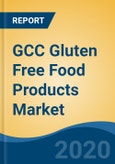Speak directly to the analyst to clarify any post sales queries you may have.
10% Free customizationThis report comes with 10% free customization, enabling you to add data that meets your specific business needs.
Key Market Drivers
Increasing Gluten Sensitives
The increasing prevalence of gluten sensitivities is a key driver of growth in the GCC gluten-free food products market. As awareness of gluten-related health issues such as celiac disease, wheat allergies, and non-celiac gluten sensitivity rises, more consumers are adopting gluten-free diets to manage these conditions. The symptoms associated with gluten sensitivities, including bloating, fatigue, and digestive discomfort, have made people more conscious of their food choices, leading to a growing demand for gluten-free alternatives.As more individuals are diagnosed with gluten sensitivities, the need for safe, convenient, and accessible gluten-free food options increases, prompting both local and international food brands to expand their product offerings. This trend is not limited to those with medical conditions but is also observed among health-conscious individuals seeking to improve their overall well-being. Consequently, supermarkets, restaurants, and foodservice providers in the GCC region are increasingly stocking gluten-free products, further boosting the market.
Key Market Challenges
Lack of Awareness Among Consumers
Lack of awareness among consumers remains a significant challenge for the GCC gluten-free food products market. While there has been growing recognition of gluten-related health issues like celiac disease and gluten sensitivity, many consumers in the GCC region are still unfamiliar with the concept of gluten intolerance and its potential health impacts. This lack of understanding often leads to skepticism or hesitation in adopting gluten-free products, particularly among those who do not experience any visible symptoms or do not perceive the benefits of a gluten-free lifestyle.Also, many consumers may not fully comprehend the wide range of health benefits associated with gluten-free diets, such as improved digestion, reduced inflammation, and better overall well-being. This gap in consumer knowledge can hinder the broader acceptance and consumption of gluten-free products, limiting market growth. To address this challenge, education and awareness campaigns are crucial. Manufacturers, healthcare professionals, and government bodies need to work together to educate consumers on the importance of gluten-free diets, not only for individuals with medical conditions but also for those seeking a healthier lifestyle. As awareness grows, it is expected that more consumers will make informed dietary choices, ultimately expanding the GCC gluten-free food products market.
Key Market Trends
Celebrity & Influencer Endorsements
Celebrity and influencer endorsements are becoming a prominent trend in the GCC gluten-free food products market. As social media platforms like Instagram, YouTube, and TikTok continue to grow, influencers and celebrities play a crucial role in shaping consumer perceptions and preferences. Many well-known personalities are increasingly promoting gluten-free diets and products, leveraging their platforms to raise awareness about the benefits of gluten-free eating. These endorsements often create a sense of trust and credibility, encouraging followers to explore gluten-free alternatives. Influencers have a significant impact on the purchasing decisions of younger, health-conscious consumers.They frequently share personal experiences, recipes, and product recommendations, making gluten-free products more appealing and accessible. Also, these endorsements not only highlight the health benefits of gluten-free foods but also promote the lifestyle aspect, associating gluten-free eating with wellness, energy, and overall better living. As celebrities and influencers continue to endorse gluten-free products, their reach helps to normalize these dietary choices, expanding the market and encouraging more consumers in the GCC region to adopt gluten-free alternatives. This trend is expected to drive the continued growth of the gluten-free food sector by influencing both consumer attitudes and purchasing behavior.
Key Market Players
- Modern Bakery LLC
- Solico Group
- DR SCHÄR AG
- The Bread Factory Limited
- Conagra Brands, Inc
- The Hain Celestial Group
- General Mills Inc
- Kellanova
- The Kraft Heinz Company
- Mrs Crimble’s
Report Scope:
In this report, the GCC Gluten Free Food Products Market has been segmented into the following categories, in addition to the industry trends which have also been detailed below:- GCC Gluten Free Food Products Market, By Product Type
- Bakery & Confectionery
- Dairy & Frozen Dessert
- Beverages
- Meat Products
- Others
GCC Gluten Free Food Products Market, By Distribution Channel:
- Store-Based
- Non-Store Based
GCC Gluten Free Food Products Market, By Country:
- Saudi Arabia
- UAE
- Qatar
- Oman
- Bahrain
- Kuwait
Competitive Landscape
Company Profiles: Detailed analysis of the major companies present in the GCC Gluten Free Food Products Market.Available Customizations:
With the given market data, the publisher offers customizations according to a company's specific needs. The following customization options are available for the report.Company Information
- Detailed analysis and profiling of additional market players (up to five).
This product will be delivered within 1-3 business days.
Table of Contents
Companies Mentioned
- Modern Bakery LLC
- Solico Group
- DR SCHÄR AG
- The Bread Factory Limited
- Conagra Brands, Inc
- The Hain Celestial Group
- General Mills Inc
- Kellanova
- The Kraft Heinz Company
- Mrs Crimble’s








